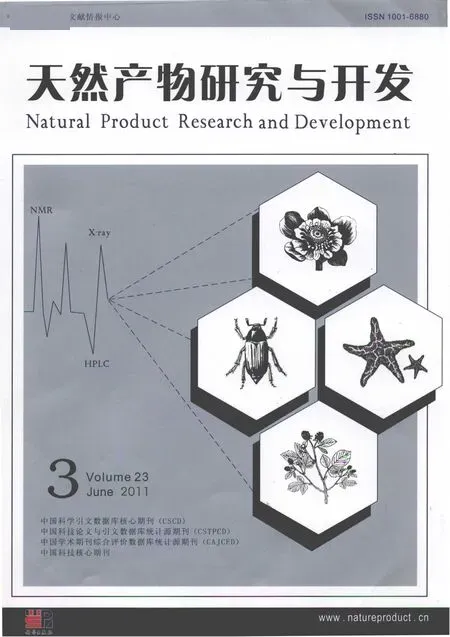中华小苦荬萜类化学成分的研究
马雪梅,马文兵
中华小苦荬萜类化学成分的研究
马雪梅*,马文兵
中北大学化工与环境学院,太原030051
从中华小苦荬全草的乙酸乙酯提取物中分离得到8个萜类化合物,通过波谱方法及文献对照分别鉴定为β-香树脂素(1),3β-羟基-20(30)-蒲公英甾烯(2),熊果-12-烯-3β-醇(3),羽扇豆醇(4),10-羟基艾里莫芬-7 (11)-烯-12,8α-内酯(5),乌苏-12,20(30)-二烯-3β,28-二醇(6),3β,8α-二羟基-6β-当归酰基艾里莫芬-7(11)-烯-12,8β-内酯(7)和乌苏酸(8),化合物1~8均首次从该植物中分离得到。
中华小苦荬;萜类;化学成分
Introduction
Ixeridium chinense,a herbaceous perennial plant belonging to the Compositae family,is widly distributed in Shanxi,Shandong and Henan provinces of China growing at230-4700 m above sea level.It is valued as delicious and nutritional potherb[1-3].Up to now,its chemical constituents have not been investigated.In a continuing deep investigation of our studies on natural products with free-radical-screening activities and bioactive terpenoids from Ixeridium class[4],we carried out phytochemical studies on this plant and eight terpenoid compounds were isolated from an EtOAc extract of the whole plant of I.chinense.We report herein the isolation and structural elucidation of all these compounds.
Materials and Methods
Apparatus and Materials
1H NMR,13C NMR and DEPT spectra were recorded on Varian INOVA-400 FT-NMR spectrometer.IR were recorded on Nicolet NEXUS-670 FT-IR spectrometer.Column chromatographies(CC)were performed on silica gel(200-300 mesh,Branch of Qingdao Haiyang Chemical Plant).Melting points were recorded X-4 melting point apparatus and uncorrected.
The Ixeridium chinense were collected from Taiyuan of Shanxi province,in June 2007.It was authenticated by Professor Guo wen-ju,ShanXi Institute for Drug Control.
Extraction and Isolation
Ixeridium chinense(4.0 kg)were extracted four times with 75%EtOH at room temperature,and each time lasted three days.The combined extracts were evaporated to dryness under reduced pressure.The residue(120 g)was then suspended in H2O(1.2 L),and extracted with petroleum ether(60-90℃)(1.2 L× 6),ethyl acetate(1.2 L×4)and n-butanol(1.0 L ×4),respectively.The EtOAc extraction was concentrated to a syrup(52 g),and then subjected to chromatographic separation on a silica gel column(100-200 mesh,600 g).The components of the mixture were chromatographyed using petroleum ether with increasing volume of acetone(v/v,from 30∶1 to 1∶1)as eluent to give seven fractions(Fr.1-Fr.7).Rechromatography on silica gel(200-300 mesh)with petroleum ether-EtOAc(v/v,10∶1)as eluent,Fr.1(v/v,from 30∶1 to 25∶1)yielded pure compound 1(15 mg).Fr.2 (v/v,from 25∶1 to 20∶1)was eluted with petroleum ether-ethyl acetate(v/v=20∶1)to give crude compound 1(8 mg)and compound 2(6 mg).Fr.3(v/v,from 20∶1 to 15∶1)was eluted with petroleum etherethyl acetate(v/v=15∶1)to give compound 3(12 mg).Fr.4(v/v,from 15∶1 to 12∶1)gave compound 4 (9 mg)after CC on silica gel eluted with petroleum ether-ethyl acetate petroleum ether-ethyl acetate(v/v,10∶1).Fr.5(v/v,from 12∶1 to 10∶1)was chromatographed using petroleum ether-acetone(v/v,12∶1)as eluent to afford compound 5(12 mg).Fr.5(v/v,from 12∶1 to 10∶1)was chromatographed using petroleum ether-acetone(v/v,10∶1)as eluent to give compound 6.Fr.6(v/v,from 10∶1 to 5∶1)was chromatographed using petroleum ether-acetone(v/v,8∶1)as eluent to afford compound 7(10 mg).Fr.7(v/v,from 5∶1 to 1∶1)afforded compound 8(19 mg)after CC on silica gel eluted with petroleum ether-acetone(v/v,2∶1).
Identification
β-amyrin(1)Colorless needles,mp.195-197℃.1H NMR(CDCl3,400 MHz)δ:5.14(1H,t,J= 4.0 Hz,H-12),3.22(1H,m,H-3),0.97(3H,s,H-23),0.79(3H,s,H-24),0.77(3H,s,H-25),1.00 (3H,s,H-26),1.14(3H,s,H-27),0.83(3H,s,H-28),0.88(6H,s,H-29,30).13C NMR(CDCl3,100 MHz)δ:38.6(C-1),27.2(C-2),79.1(C-3),38.7 (C-4),55.1(C-5),18.4(C-6),32.8(C-7),39.9(C-8),47.7(C-9),36.8(C-10),23.2(C-11),121.3(C-12),145.5(C-13),42.0(C-14),26.8(C-15),26.6 (C-16),32.7(C-17),48.2(C-18),46.6(C-19),31.6(C-20),34.2(C-21),37.5(C-22),28.1(C-23),15.6(C-24),15.6(C-25),16.8(C-26),26.4 (C-27),28.2(C-28),33.3(C-29),23.4(C-30).The spectral data were in accordance with those of reported[5],then the compound 1 was identified asβ-amyrin.
3β-hydroxyl-20(30)-taraxastene(2)Colorless crystals,mp.278-280℃.1H NMR(CDCl3,400 MHz) δ:3.17(1H,m,H-3),4.64(1H,brs,H-30β),4.60 (1H,brs,H-30β).13C NMR(CDCl3,100 MHz)δ: 38.6(C-1),27.4(C-2),79.0(C-3),38.8(C-4),55.3(C-5),18.3(C-6),34.2(C-7),14.5(C-8),50.5(C-9),37.1(C-10),21.6(C-11),26.2(C-12),39.2(C-13),42.2(C-14),26.7(C-15),38.3(C-16),34.2(C-17),48.7(C-18),39.4(C-19),154.6 (C-20),25.6(C-21),38.9(C-22),27.9(C-23),15.4(C-24),16.3(C-25),15.9(C-26),14.8(C-27),19.5(C-28),25.5(C-29),107.1(C-30).The data was in accordance of3β-hydroxyl-20(30)-taraxastene[6].
Olean-12-ene-3β-ol(3)Colorless crystal,mp.307-309℃.1H NMR(CDCl3,400 MHz)δ:3.63(1H,t,J =6.6 Hz,H-3),5.18(1H,m,H-12),0.99(3H,s,H-23),0.80(3H,s,H-24),0.95(3H,s,H-25),0.96(3H,s,H-26),1.14(3H,s,H-27),0.84(3H,s,H-28),0.87(3H,s,H-29),0.88(3H,s,H-30);13C NMR(CDCl3,100 MHz)δ:38.8(C-1),27.5(C-2),79.2(C-3),38.9(C-4),55.4(C-5),18.5(C-6),32.9(C-7),39.6(C-8),47.8(C-9),37.4(C-10),23.2(C-11),121.7(C-12),144.8(C-13),42.0(C-14),26.4(C-15),26.9(C-16),33.1(C-17),47.5 (C-18),46.9(C-19),31.2(C-20),35.1(C-21),38.1(C-22),28.2(C-23),15.6(C-24),15.7(C-25),17.1(C-26),26.5(C-27),29.3(C-28),33.3 (C-29),23.5(C-30).The data were in accordance with those of reported[6],then the compound 3 was identified as olean-12-ene-3β-ol.
Lupol(4)White needles,mp.208-210℃.1H NMR (CDCl3,400 MHz)β:3.18(1H,m,H-3),0.85(3H,s,H-23),0.76(3H,s,H-24),0.83(3H,s,H-25),1.03(3H,s,H-26),0.91(3H,s,H-27),0.75(3H,s,H-28),4.64(1H,brs,H-29),4.54(1H,brs,H-29'),1.12(3H,s,H-30).13C NMR(CDCl3,100 MHz)δ:36.9(C-1),27.9(C-2),78.9(C-3),38.8 (C-4),55.1(C-5),18.2(C-6),34.1(C-7),40.8(C-8),50.3(C-9),37.25(C-10),20.76(C-11),25.17 (C-12),37.23(C-13),42.1(C-14),27.3(C-15),35.2(C-16),42.5(C-17),48.6(C-18),47.7(C-19),150.4(C-20),30.5(C-21),38.8(C-22),27.9 (C-23),15.3(C-24),16.1(C-25),15.9(C-26),14.6(C-27),17.3(C-28),109.5(C-29),20.6(C-30).The data were in accordance with those of reported[7,8],then the compound 4 was identified as lupol.
10-hydroxyeremophil-7(11)-en-12,8α-olide(5) Colorless crystals,mp.170-172℃.IRνmarcm-1:3501,1772,675,1445;1H NMR(CDCl3,400 MHz)δ:4.85 (1H,dd,J=6.8,11.2 Hz,H-8),2.60(1H,s,H-6α),2.40(1H,m,H-6β),2.12(1H,dd,J=6.8,14.2 Hz,H-9α),1.86(1H,dd,J=11.2,14.2 Hz,H-9β),1.72(3H,s,CH3-13),1.75(1H,m,H-1α),1.77(1H,m,H-1β),1.42(1H,m,H-2α),1.37(1H,m,H-2β),1.43(1H,m,H-3α),1.36(1H,m,H-3β),1.21(1H,m,H-4),0.96(3H,s,CH3-14),0.80 (3H,d,J=8.4 Hz,CH3-15);13C NMR(CDCl3,100 MHz)δ:36.8(C-1),22.5(C-2),28.2(C-3),32.9 (C-4),45.4(C-5),31.5(C-6),160.9(C-7),79.6 (C-8),41.8(C-9),76.4(C-10),121.5(C-11),174.7(C-12),8.9(C-1),15.4(C-14),16.4(C-15).The NMR data were identical to those of literature,the compound 5 was identified as 10-hydroxyeremophil-7(11)-en-12,8α-olide[9].
Ursan-12,20(30)-dien-3β,28-diol(6)Colorless crystals,mp.230-231℃.1H NMR(CDCl3,400 MHz) δ:3.64(t,J=6.6 Hz,H-3),5.14(m,H-12),4.68 (brs,H-30),4.58(brs,H-30'),0.75-1.60(CH3or CH2);13C NMR(CDCl3,100 MHz)δ:38.8(C-1),27.5(C-2),79.2(C-3),38.9(C-4),55.4(C-5),18.5(C-6),32.9(C-7),39.6(C-8),47.8(C-9),37.4(C-10),23.5(C-11),124.7(C-12),139.8(C-13),43.0(C-14),29.4(C-15),22.9(C-16),37.1 (C-17),55.5(C-18),38.9(C-19),151.2(C-20),32.1(C-21),38.8(C-22),28.2(C-23),15.6(C-24),15.7(C-25),17.0(C-26),23.5(C-27),63.3 (C-28),16.3(C-29),109.5(C-30).The data were equal to those reported[10],then the compoud 6 was identified ursan-12,20(30)-dien-3β,28-diol.
3β,8α-dihydroxyl-6β-angloxyeremophil-7(11)-en-12,8β-olide(7)Colorless crystals,mp.196-199℃.1H NMR(CDCl3,400 MHz)δ:3.78(1H,dd,J= 6.0,3.0 Hz,H-3),6.24(1H,brs,H-6),2.36(1H,m,H-9α),2.09(1H,dd,J=14.2,11.2 Hz,H-9β),1.70(3H,d,J=1.2 Hz,CH3-13),1.26(3H,s,CH3-14),0.94(3H,d,J=5.2 Hz,CH3-15),6.35(1H,qq,J=6.6,1.2 Hz,H-3'),2.03(3H,dq,J=7.5,1.2 Hz,CH3-4'),1.92(3H,dq,J=6.0,1.3 Hz,CH3-5');13C NMR(CDCl3,100 MHz)δ:27.8(C-1),29.5(C-2),68.2(C-3),39.9(C-4),47.4(C-5),71.5(C-6),157.8(C-7),105.6(C-8),39.8(C-9),37.4(C-10),127.5(C-11),172.7(C-12),8.8(C-13),20.4(C-14),167.4(C-15),168.2(C-1'),128.5(C-2'),140.2(C-3'),21.9(C-4'),15.4(C-5').The data were in accordance with those of literature[9],then the compound 7 was identified as 3β,8αdihydroxyl-6β-angloxyeremophil-7(11)-en-12,8β-olide.
Ursolic acid(8)White powder,240-242℃.1H NMR(DMSO-d6,400 MHz)δ:8.34(1H,s,COOH),5.16(2H,t,H-12),3.18(2H,m,H-3);13C NMR (DMSO-d6,100 MHz)δ:38.8(C-1),27.4(C-2),77.8(C-3),38.3(C-4),54.7(C-5),17.9(C-6),32.8(C-7),39.1(C-8),37.9(C-9),36.4(C-10),23.2(C-11),124.5(C-12),138.1(C-13),41.5(C-14),28.1(C-15),23.8(C-16),46.7(C-17),52.2 (C-18),38.4(C-19),38.4(C-20),30.2(C-21),36.2(C-22),28.2(C-23),15.9(C-24),15.2(C-25),16.9(C-26),23.2(C-27),178.1(C-28),22.9 (C-29),19.9(C-30).The data were consistent with those of ursolic acid[11],the compound 8 was identified as ursolic acid.
1 Flora of China Editorial Committee,Chinese Academy of Sciences.Flora of China,Beijing:Science Press.2005,80:251.
2 Whang SS,Choi K,Robert SH,et al.A morphometric analysis of infraspecific taxa within the Ixeris chinensis complex (Asteraceae,Lactuceae).Bot Bull Acad Sin,2002,43:131-138.
3 Beijing institute of botany,Chinese Academy of Sciences.The Picture Index of Senior China Plant.Beijing:Science Press,1975,4:708.
4 Ma XM,Liu Y,Shi YP.Phenolic derivatives with free-radical-scavenging activities from Ixeridium gracile(DC.)Shih.Chem&Biodiver,2007,9:2172-2181.
5 Yang AM,Liu X,Lu RH,et al.Triterpenoids from Pyrethrum tatsienense.Pharmazia,2006,61:70-73.
6 Mahato SB,Kundu AP.13C NMR spectra of pentacyclic triterpenoids-a compilation and some salient features.Phytochemistry,1994,37:1517-1575.
7 Qi SH,Wu DG,Ma YB,et al.Studies on chemical constituents of Lagerstroemia guilinensis.Chin Tradit Herb Drugs,2002,33:879-880.
8 Liu RH,Kong LY.Lipid constituents from Euphorbia humifusa wild.Nat Prod Res Dev(天然产物研究与开发),2005,17:437-439.
9 Sugama K,Hayashi K,Mitsuhashi H.Eremopilenolides from Petusites japonicus.Phytochemistry,1985,24:1531-1535.
10 Al-Easa HS,Rizk AM,Ahmed AA.Guaianolides from Picris radicata.Phytochemistry,1996,43:423-424.
11 Bhandari SPS,Gang HS,Agrawal PK,et al.Ursane triterpenoids from Nepeta eriostachia.Phytochemisty,1990,27: 3956-3958.
Terpenoids from Ixeridium chinense(Thunb.)Tzvel.
MA Xue-mei*,MA Wen-bing
College of Chemical Engineering and Environment,North University of China,Taiyuan 030051,China
Eight terpenoids have been isolated from the ethyl acetate extract of Ixeridium chinense(Thunb.)Tzvel by using column chromatography and preparative thin layer chromatography.Structures for allthese compounds were proposed on the basis of spectroscopic data,together with comparing their spectral data with those of the corresponding compounds reported in the literature.They were identified asβ-amyrin(1),3β-hydroxyl-20(30)-taraxastene(2),olean-12-ene-3βol(3),lupol(4),10-hydroxyeremophil-7(11)-en-12,8α-olide(5),ursan-12,20(30)-dien-3β,28-diol(6),3β,8αdihydroxyl-6β-angloxyeremophil-7(11)-en-12,8β-olide(7)and ursolic acid(8).Compounds 1-8 were obtained from this plant for the first time.
Ixeridium chinense;terpenoids;chemical constituents
October 9,2009;Accepted January 15,2010
book=2011,ebook=1
R284.2;Q946.91
A
1001-6880(2011)03-0440-04
*Corresponding author Tel:86-351-3629665;E-mail:maxuemei@live.nuc.edu.cn
- 天然产物研究与开发的其它文章
- 石菖蒲的化学成分研究
- 海芒果叶中三萜类成分的研究
- 香青兰酚酸性化学成分的研究

